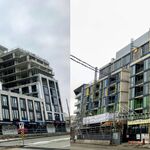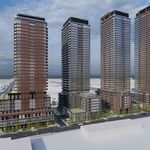turbanplanner
Senior Member
Is that really relevant though? This is an extreme echo chamberIf you want to defend the choice, go ahead, though you probably won't get much support around here!
Is that really relevant though? This is an extreme echo chamberIf you want to defend the choice, go ahead, though you probably won't get much support around here!
I know exactly where this is and got a coffee at that McDonald's!
I would pedestrianize Queen from Dufferin to Church. Way more pedestrians use it than vehicles. Or even Lansdowne.
Queen Street would probably be the better option for a transit mall, but to put things into a Toronto context Bourke Street is 3 km long and the transit mall is roughly 250 m.
That would be like putting the 501 in a ROW from Bathurst to Parliament and having a transit mall from Spadina to Peter.
Lansdowne to Church is over 5 km.
step 1: get King + Queen in their own ROW downtown (Bathurst to Parliament/River)
step 2: repeat step 1 for Dundas + College
step 3: make a transit mall between Spadina + Peter.
step 4: once the mall is overwhelmingly loved expand it east and west, while creating new ones elsewhere.
Yeah, but you ask for the whole thing, and then agree that step 1 is a great startLansdowne to Church is over 5 km.
step 1: get King + Queen in their own ROW downtown (Bathurst to Parliament/River)
step 2: repeat step 1 for Dundas + College
step 3: make a transit mall between Spadina + Peter.
step 4: once the mall is overwhelmingly loved expand it east and west, while creating new ones elsewhere.
Delivers should really be after hours. Either early in the morning or late at night. No one needs cabs and trucks blocking the view in the day.I always thought they should have made King and Queen street transit malls with bike lanes on each, ban cars (except deliveries) and have left Richmond and Adelaide alone and left for cars/deliveries. This makes a lot more sense to me, theres nothing on Rich and Adelaide really it makes no sense to have bike lanes on those streets and cars on Queen. The majority of the shipping access for shops on Queen/King are on Rich/Adelaide anyways too.
This seems to always be the argument… However, from a quick Googlewalk along King between Spadina and University it appears that loading and parking is off the side streets, (I may missed something because the camera drives beside a streetcar for a block.) For the possibility that there is one than you allow those residents to be permitted to access the garage. I‘ve seen this compromise in Germany and it seems to work.I'm pretty sure s/he means condos, offices, and building services, such as loading or garbage disposal. Many can only be accessed via King Street and there is no viable alternative. Also, people paid $100K for their underground parking spots.
So, you do have to maintain some car access. Perhaps there are solutions, such as retractable bollards for residents, or restricting deliveries to certain times. It certainly is easier to pedestrianize European roadways that existed before cars and garages were common, or if the pedestrianization is planned in advance.
Personally, I've never thought King Street was the best candidate for full pedestrianization. I'd be more in favour of eliminating lanes and expanding sidewalks, while maintaining limited vehicle access.
If it were me, I'd pedestrianize Queen Street from University to Victoria / Church. We're about to get the biggest pilot project of all time with the Ontario Line construction
It’s used as a line of attack to preserve the status quo. While those in favor of pedestrianizing are often seen providing alternatives, those with the dismissal often shoot them down with nothing more than “it won’t work”.This seems to always be the argument
I agree that retractable bollards can be problematic and using them at many intersections along King is probably not necessary. It should be fine to make King car-lite by prohibiting through movement (ie, permanent red light at each intersection, right turn only, transit vehicles use a transit signal), eliminating curbs and replacing the asphalt with pavers that would be uncomfortable to drive at high speed on. Create some designated loading bays off the streetcar ROW for deliveries. Add furniture and street trees in the current drive lanes to provide enough visual obstacles to dissuade anyone from thinking they can zip down the street in a car.At the risk of being repetitive either of myself or others.......
1) A shift towards pedestrianization in many spots, and towards more exclusive ROW for transit (King Streetcar in this case specifically) is certainly something I support.
2) For a variety of reasons, attempting it at-scale, in the near-term is unlikely.
3) While I find some of the 'anti' arguments as tiresome as the rest of you; I think its important not to be dismissive; but rather focus on addressing any specifics (which I know many of you have)
For instance; Is Toronto different from 'x' city in Europe? Yes, in a number of ways; however, the onus should be on the person offering that argument to explain what difference or differences they feel obstruct choice A or B; so that we
can thoughtfully discuss how these might be addressed.
Some of the challenges are very real, and some are not necessarily fixable in the same way as City 'x' without a series of other changes. For instance, rising/retracting bollards and road salt are not a good mix.
From a manufacturer of this type of system:
View attachment 480727
There are also issues with the hydraulics function in extreme cold.
Also utility conflicts can be a major hassle.
None of which is to say that we can't use this tech here, but its not as easy as choose this tech, order, install. There's a lot of moving parts.
4) Lane widths would be a real issue on much of King in terms of exclusive ROW. These potentially go away in a pedestrian-only/pedestrian priority design depending what level of vehicle accommodation is required (ie. garbage trucks etc.)
You can 'designate' an ROW, but if you want it separated by curbs from the curb lane, you need to account for the space taken up by the curb, that it either needs to be low enough that the flexities pass over it, or be set back slightly to allow for sway. And Transportation is simply not going to below 3.0M for lane width for a through lane.
*****
For the reasons above. I would be inclined to make some different changes.
1) I would do a pedestrianization project specifically from Duncan to Widmer. Its short, but it would serve Princess of Wales and TIFF, and by creating a break where you physically can't through-run a car on King West, it will automatically shift some traffic to other roads/cause some shift in modality.
2) I would focus on creating full, permanent, bumped-out, streetscaped platforms for the various far-side loading stops. This will improve safety and aesthetics of pedestrians and transit riders, and make it more difficult for vehicles to use King.
3) I would extending the on-street parking prohibition the length of the route, with the possible exception of Roncy. That means all of King, Queen from King to Broadview, Broadview from Queen to Broadview Station.
I think those things would improve reliability and run times, and they don't require any new technologies or undue controversy.
All of these things may (or may not) be part of the final configuration of King Street The rebuild was supposed to happen in 2024 or 2025 when the streetcar tracks were to be replaced (and maybe the watermain?). With Queen closed I bet zero will happen until it reopens and I have seen no word of any discussions on exactly what the re-build will entail. See https://www.toronto.ca/city-governm...anning-studies-initiatives/king-street-pilot/I agree that retractable bollards can be problematic and using them at many intersections along King is probably not necessary. It should be fine to make King car-lite by prohibiting through movement (ie, permanent red light at each intersection, right turn only, transit vehicles use a transit signal), eliminating curbs and replacing the asphalt with pavers that would be uncomfortable to drive at high speed on. Create some designated loading bays off the streetcar ROW for deliveries. Add furniture and street trees in the current drive lanes to provide enough visual obstacles to dissuade anyone from thinking they can zip down the street in a car.
On the subject of utilities. I think it might be useful for some of you to see what an actual intersection in downtown Toronto looks like, below the surface, so you can understand the challenges faced by City units trying to improve them.
View attachment 480730




